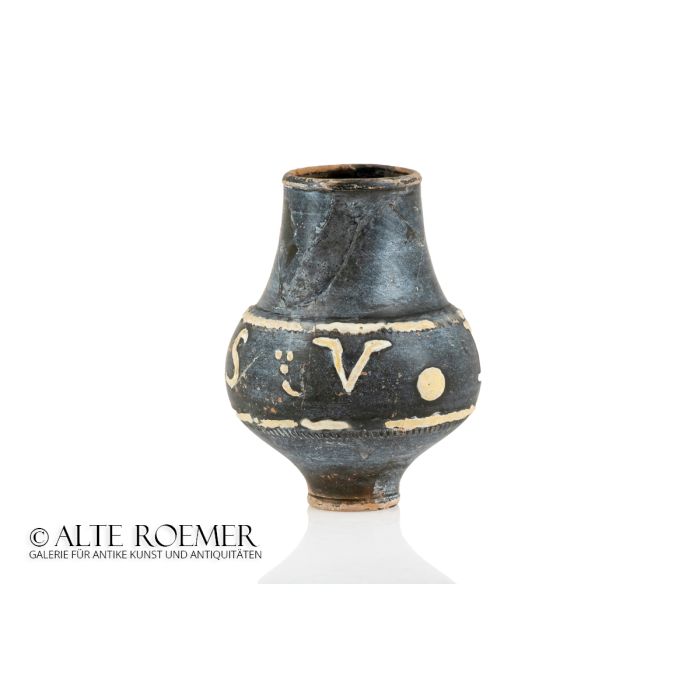Roman terracotta beaker from the Rhineland with painted inscription
Price: on request
Sold
Object number
AR3400A25
| Object: |
Beaker (so called "Spruchbecher", i.e. beaker with a saying) |
| Material: |
Terracotta (red clay) with white barbotine
|
| Date: |
Second half 3rd - early 4th century A.D. Late Roman Empire |
| Description: |
Globular beaker. Foot profiled with semi-bead-molding. Conical neck, lip with bead-molding. The inscription VIVAS (= live!) is applied in white barbotine or paint. The first four letters are separated by big white spots, no spot between A and S. A separator consisting of three small dots and line between S and V. Above and below band of fine indentations, covered by a band in white color. |
| Dimensions: |
Diameter 73 mm, height 94 mm
|
| Condition: |
The inscription is perfectly preserved, worth the exhibition in a museum. The vessel professionally restored from few fragments, not remodeled, no parts missing.
|
| References: |
For the shape (Künzel Typ 1.4), see e.g.: Beaker with Accession Number 17.194.844 at the Metropolitan Museum of Art, New York City. S. Künzel, Die Trierer Spruchbecherkeramik (Trier 1997) KRE 121, p. 193 and Pl. 20a-d For the inscription: S. Künzel, Die Trierer Spruchbecherkeramik (Trier 1997) collocation on p. 259 s.v. VIVAS. Corpus Inscriptionum Latinarum XIII, Inscriptiones trium Galliarum et Germaniarum Latinae. Fasc. 2: Instrumentum domesticum II. Ed. O. Bohn (Berlin 1906) Nr. 197 p. 552-3. E. Harsanyi, Die Trierer schwarz engobierte Ware in Noricum und Pannonien (2014) p. 88 |
| Literature: |
Another very extensive work on the terracotta beaker with sayings is: E. Harsanyi, Die Trierer schwarz engobierte Ware und ihre Imitationen un Noricum und Pannonien (Graz 2013) From the extensive literature on Roman Neuss, we would like to refer to one more general book and one exemplary description of an excavation. Both were written by local archaeologists who were friends of Mr. Voigtmann. H. Chantraine, Dr. G. Mueller, Das roemische Neuss (Stuttgart 1984). D. Haupt, Die Kleinfunde eines roemischen Landhauses aus Neuss-Weckhoven, in Beitraege zur Archaeologie des roemischen Rheinlandes, Rheinische Ausgrabungen 3 (1968). |
| Provenance: |
Acquired by us in 2021 from the German family estate Voigtmann. The founder of the collection, Mr. Heinz Voigtmann, carried out excavations himself between 1966 and 1981, in cooperation with local archaeologists. The beaker offered here comes from his finds near Neuss, Germany, the former Roman city of Novaesium. The Voigtmann Collection is a private collection built with passion and expertise. It included objects from the Roman Imperial period, as well as isolated objects from the Middle Ages, above all everyday pottery, but also glasses, bronzes and works of ivory. All come from the Roman city of Novaesium and its immediate vicinity. Mr. Voigtmann himself conducted excavations and recovered the objects for which the local archaeologists had no research capacities and which without him would have been lost forever. He shared his finds with the world of academia. He was in constant contact with the archaeologists Dr. Gustav Mueller, Dr. Ernst Kuenzl and Dr. Dorothea Haupt from the Rheinisches Landesmuseum Bonn, as well as with Prof. Dr. Hilmar von Platen from the University of Mainz. The Rheinisches Landesmuseum Bonn, for example, mentions the Voigtmann Collection among its new accessions from 1971. With his academic contacts and his skill as a restorer, Mr. Voigtmann devoted himself to the detailed restoration and reconstruction of the fragmentary vessels and even the sherds in his collection. This service for the preservation of the cultural heritage of the city of Neuss is unique and would not have been feasible with this effort, neither in research nor in the art market. We have the utmost respect for this life's work and have intensively curated and digitized the collection in order to preserve the provenance information and academic notes handed down for posterity in the long term. Novaesium was an early Roman foundation in the province of Germania inferior, making it one of the oldest cities in Germany. The place of its founding was certainly inhabited before the Romans and was strategically well located for holding Gaul. It was at the end of a Roman long distance road and close to the Rhine, Erft, Lippe, Ruhr and Wupper waterways. Traders settled and permanently stationed soldiers secured the junction and the nearby Limes. No wonder that today's Neuss is rich in archaeological finds, legacies from the Roman legions, as well as commercial goods and household goods from the Roman civilian population. The Voigtmann Collection forms a perfect cross-section of Roman Novaesium through the exclusively local finds and the specialization on the first centuries AD. |
| Authenticity: |
We unconditionally guarantee the authenticity of every artefact, all items are subject to our lifetime return policy on authenticity.
|


